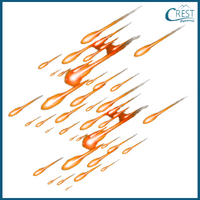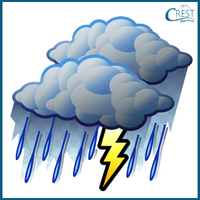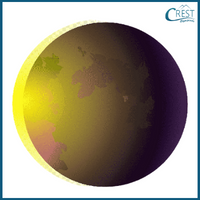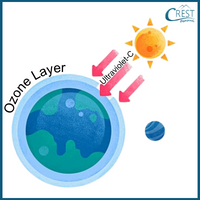1. A balloon was inflated and tied. When a needle was inserted into the balloon, it burst with a loud pop.

What does this observation imply?
a) Air occupies space
b) Air has weight
c) Air is invisible
d) Air exerts pressure
Answer: d) The observation of the balloon bursting when a needle is inserted implies that air exerts pressure. The air inside the balloon pushes against the walls, creating pressure. When the needle punctures the balloon, the sudden release of pressure causes it to burst with a loud sound.
2. Which of the following is an example of a phenomenon that occurs in the mesosphere?
a) 
b) 
c) 
d) 
Answer: a) Shooting stars, also known as meteors, are a phenomenon that occurs in the mesosphere. When tiny particles from outer space enter the Earth's atmosphere and burn up, they create streaks of light in the sky known as shooting starts.
3. Which of the following is an example of air exerting force on objects?
a) A seed germinating in the soil
b) A windmill rotating in the wind
c) A car moving on a road
d) A book resting on a shelf
Answer: b) A windmill rotating in the wind is an example of air exerting force on objects. The force of the moving air, or wind, pushes against the blades of the windmill, causing them to rotate. This demonstrates how air can exert a force and cause movement in objects.
4. Why is the ozone layer important for Earth's atmosphere?
a) It helps in the formation of clouds.
b) It provides a source of oxygen for breathing.
c) It prevents harmful ultraviolet rays from reaching the surface.
d) It contributes to the greenhouse effect.
Answer: c) The ozone layer is important for Earth's atmosphere because it prevents harmful ultraviolet rays from reaching the surface. These rays can cause skin damage, eye problems, and harm to ecosystems.
5. Match the following layers of the atmosphere with their characteristics.
| Column I |
Column II |
| 1. Troposphere |
A) This is the uppermost layer where artificial and weather satellites orbit. |
| 2. Stratosphere |
B) This layer experiences a significant increase in temperature with altitude and contains very little air. |
| 3. Exosphere |
C) This layer contains the ozone layer, which filters out harmful ultraviolet rays. |
| 4. Thermosphere |
D) This layer is closest to the Earth's surface and where most weather phenomena occur. |
a) 1:D, 2:C, 3:A, 4:B
b) 1:B, 2:A, 3:C, 4:D
c) 1:A, 2:C, 3:D, 4:B
d) 1:A, 2:B, 3:C, 4:D
Answer: a) Troposphere: This layer is closest to the Earth's surface and where most weather phenomena occur.
Stratosphere: This layer contains the ozone layer, which filters out harmful ultraviolet rays.
Exosphere: This is the uppermost layer where artificial and weather satellites orbit.
Thermosphere: This layer experiences a significant increase in temperature with altitude and contains very little air.






